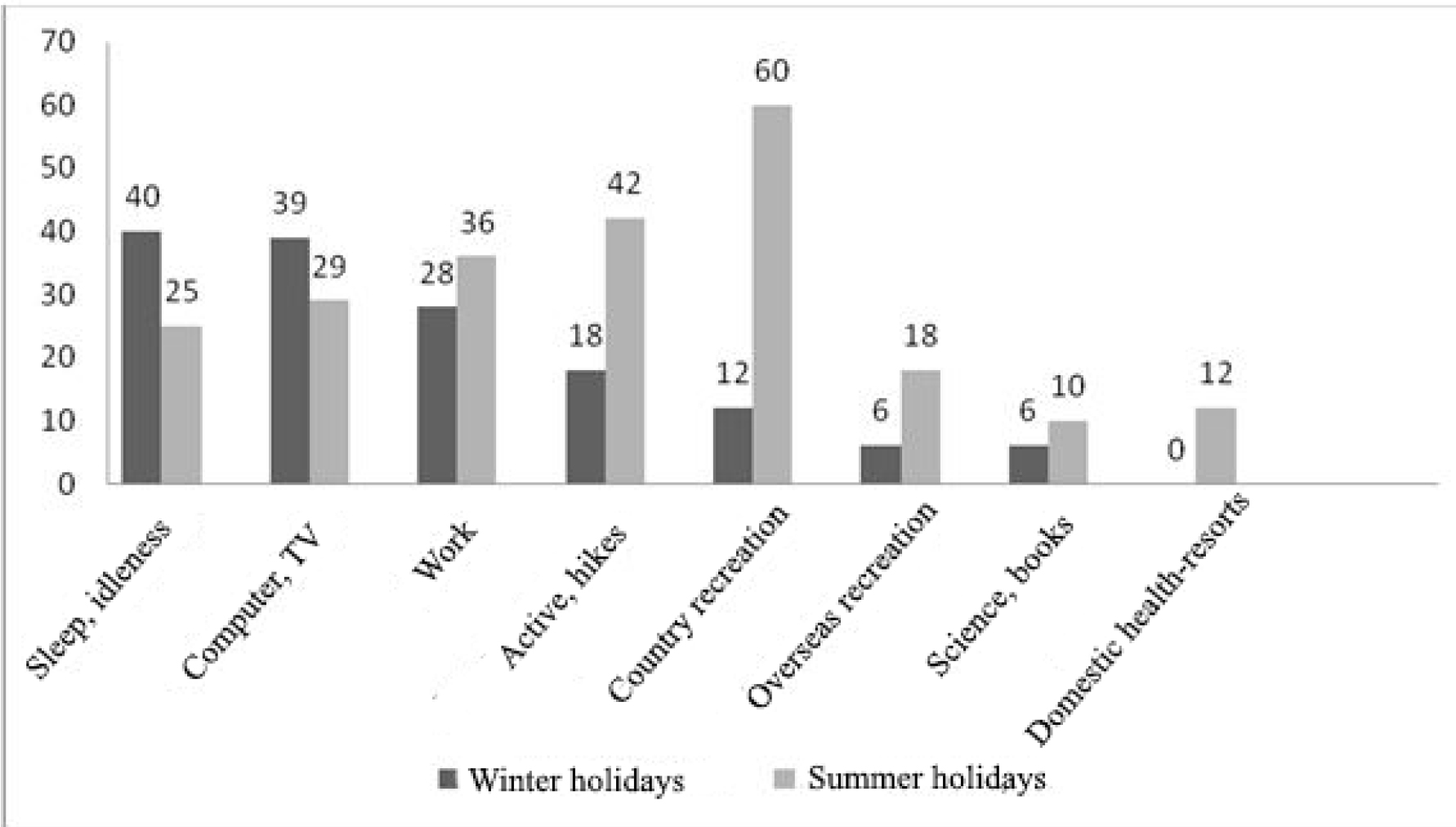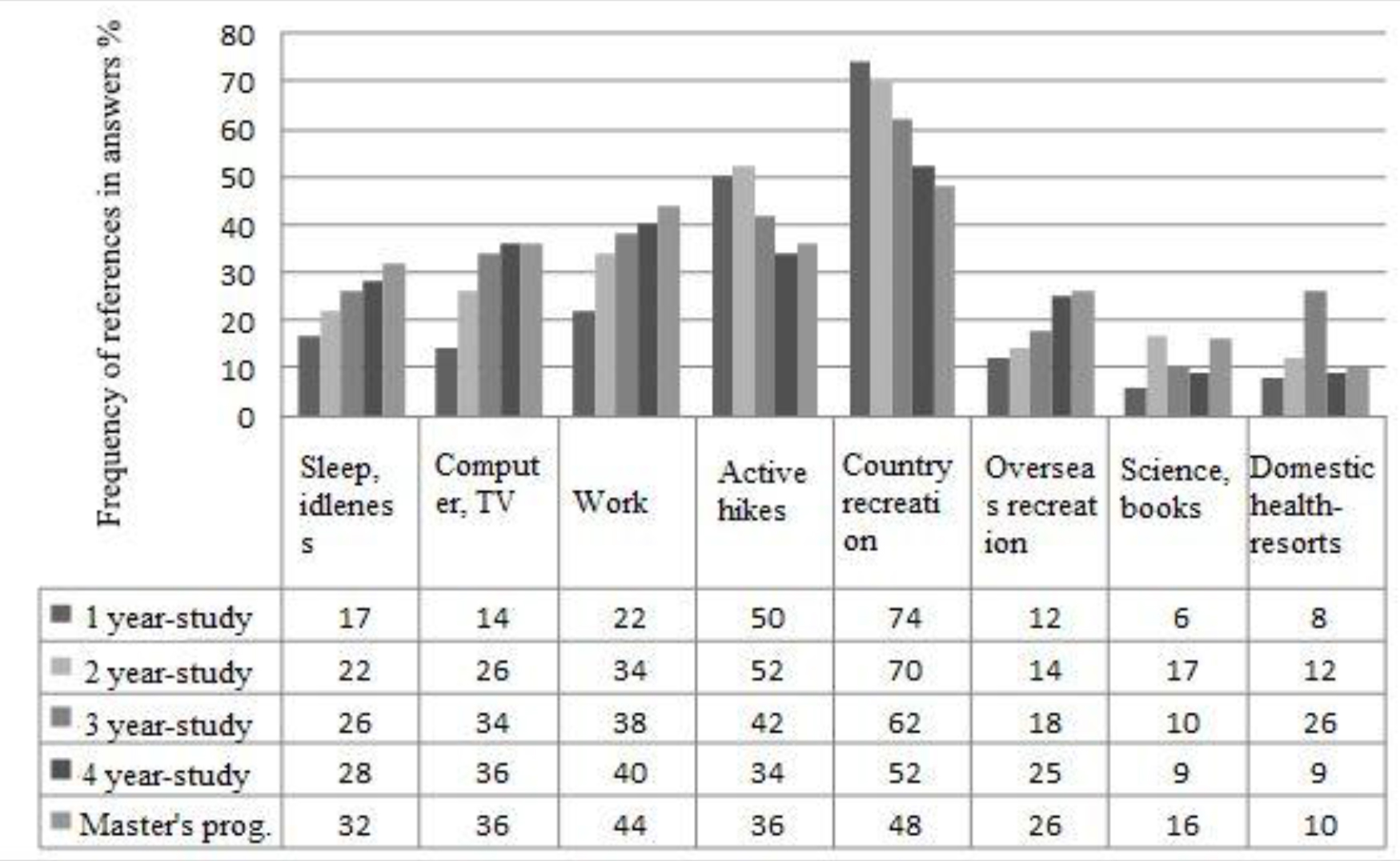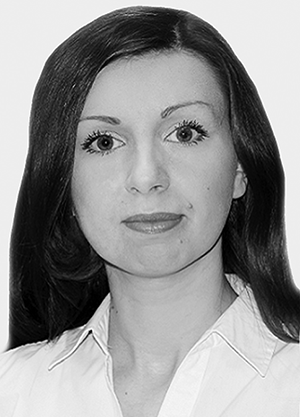Active tourism as a promising form of recreation for students on vacation
Фотографии:
ˑ:
Yu.A. Karvunis1
Professor, Dr.Med. L.V. Kapilevich1
1National Research Tomsk State University, Tomsk
Keywords: students, physical activity, health, physical education.
Introduction. In recent times, there is a positive trend of increased interest in active forms of recreation among students. Types of sports and health tourism are getting more and more popular. Mountaineering, adventure and extreme routes, geocaching become accessible for more and more young people [1]. In turn, the quality of students' recreation on vacation directly influences the effectiveness of the learning process. We consider the elaboration of the relevant modern recommendations to be important for organizing activities at higher educational institutions [2].
Objective of the study was to substantiate the role of active tourism in the organization of summer vacation of students.
Methods and organisation of research. The study has been conducted in the period from February till May 2015. The survey involved 350 students from 4 Tomsk universities (National Research Tomsk State University, National Research Tomsk Polytechnic University, Siberian State Medical University, Tomsk State University of Control Systems and Radioelectronics), who were studying according to the Bachelor’s, Specialist’s (medical) and Master’s programs. The age of the surveyed contingent ranged from 18 to 24 years. Sex of the subjects was not taken into consideration. Representativeness of sample was achieved by random sampling procedure.
Results and discussion. The findings indicate that the patterns of students’ activity during winter and summer holidays significantly differ due to a wide range of factors. Passive leisure options are more popular in winter, whereas, active forms of recreation, including tourism, are more typical of the summer season (Fig.1). In total, 28 % of students mentioned that they work during winter holidays and 38% - in summer, however the number of students working in the area of their specialization amounted to 9% and 7% respectively.

Fig.1. Students’ activity pattern characteristics during winter and summer holidays (answer choices, %)
Differentiation of indices by particular years of study (Fig.2) revealed the key trends in priority recreation variation. Demand for country recreation, all forms of active tourism, such as sports hikes, decreases. Herewith, the opportunities for overseas trips increase. No specific tendency is observed regarding the indicators of recreation at domestic health resorts, but the values make us wonder about poor domestic tourism opportunities for young people. Year after year active forms of recreation are substituted by more passive ones, along with the increasing number of employed students.

Fig. 2. Students’ activity pattern characteristics during winter and summer holidays by years of study
To the question "Have you ever taken part in hikes during holidays for the whole period of study? If yes, specify the level of complexity, 54% of students mentioned non-categorical hikes, 15% of students participated in hikes of the 1st difficulty category, 9% - 2nd category, 6% - 3rd category, 16 % mentioned that hiking is not their type of recreation. Hence, 84 % of students were more or less involved in tourist activities while studying at the university.
Research findings testify that the higher education institution infrastructure used for organizing students’ recreation during holidays does not meet the current needs and remains at a low level. Only 29 % of students more or less take the recreation, health improvement and rehabilitation facilities, provided by the university. However, just 10% of students do this on a regular basis and 65 % of them have never had an access to these resources.
61 % of all students like travelling with friends, 24 % favor family trips, 7 % prefer travelling alone, 8 % chose other variants. These indices enable to observe the student travel specifics, which consists in the fact that students are mostly not ready to travel alone; family trips become less popular compared with the previous years of study too. Travelling with friends, who have the same intentions, goals, fitness level and, usually, the same financial capacity – is a characteristic unit, which can be considered as a separate component of tourism.
We also analyzed the level of students’ self-sufficiency in the organization of recreation and determined that only 12 % of students take full advantage of services of tour operators, yet 46% of students plan their trips on their own and 28% use services of travel agencies, 14 % stated that they have not planned their trips yet. In our opinion, it proves a considerable self-sufficiency of students in planning their recreation and rather high competency in modern tourist information resources. We should also mention the insufficiently elaborated policy of travel agencies regarding increasing the share of offered youth services.
There are significant preconditions for development of active tourism in our youth city. One can go in for sports tourism in such tourist clubs of Tomsk as: “Takt” Tourist-Mountaineering club of TUSUR, TSU Mountaineering club, Altus tourclub of SSMU, Amazonki – TPU tourclub, Ariadna – TPU youth sports club, Berendei - TSU tourclub, Children’s mountaineering and ice climbing club under the guidance of Elena Temereva, Children and Youth Centre “Kedr”. 145 tourist clubs and associations are operating in the Tomsk region so far. Most of them (86) are in Tomsk and only 34 (23,5 %) – in rural areas of the region [3, 5].
In total (according to the research findings), 68% of students are content with the recreation during vacations and come back to their studies refreshed. 22 % of students are still unsatisfied with their recreation during holidays.
Herewith, it should be noted that the trends outlined in the paper should meet the Russian standards, since among 72 thousand students of Tomsk universities, 59 % are the residents of other cities and represent 75 regions of Russia [4].
Conclusion. Not more than a half of all students are involved in sports and health activities through active forms of tourism in summer. This testifies to the potential for development of this type of recreation. Active tourism should be a priority direction in the organization of summer holidays of students, as it has a positive effect on the physical and spiritual condition of individuals, has a team building effect, develops the skills necessary for further personality formation, includes the elements of environmental, regional and patriotic education.
References
- Aktivnye vidy turizma (Active forms of tourism) [electronic resource]: – Available at: http:// www.rusadventures.ru /2013.
- Karvunis Yu.A. Sostoyanie i perspektivy razvitiya aktivnogo turizma v molodezhnoy srede (State and prospects of development of active tourism among young people) / Yu.A. Karvunis, L.V. Kapilevich // Teoriya i praktika fizicheskoy kultury. – 2014. – № 10. – P. 62–64.
- Kapilevich, L.V. Sostoyanie i perspektivy razvitiya turizma v Tomskoy oblasti (State and prospects of development of tourism in Tomsk region) / L.V. Kapilevich // Vestnik natsional’noy akademii turizma. – 2010. – № 4 (16). – P. 59–61.
- Ofitsial’ny informatsionny internetportal Administratsii Tomskoy oblasti (Official information portal of Administration of Tomsk region) [electronic resource]: – Available at: http://tomsk.gov.ru/2013.
- Tomskiy klub turistov (Tomsk tourist club) [electronic resource]: – Available at: http://tourism.trecom.tomsk.ru/db/web.page?pid=3621
Corresponding author: kapil@yandex.ru


